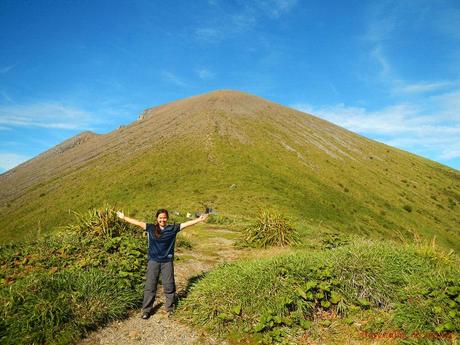
According to Philippine folklore, there once was a Negrenese princess named Anina. One day, she overheard her father talking to the kingdom’s chief priestess. It was clear that both were extremely troubled over something. When Princess Anina asked her father about it, the king broke down and said that a mighty seven-headed dragon is coming to destroy the kingdom. To appease it, an unblemished maiden must be sacrificed to it.
Fear gripped the kingdom, and women wounded and scarred their bodies to disqualify themselves from the sacrifice. The royal couple, however, didn’t have the heart to tarnish the pure beauty of their daughter. Thus, Princess Anina was the only remaining unblemished girl in the kingdom.
Princess Anina willingly offered herself as a sacrifice to the dragon, which lived in a huge mountain. But on the day of the sacrifice, a mysterious noble lord who called himself Khan Laon arrived to slay the dragon. Khan Laon said he has the ability to communicate with animals; that was the key to victory. He then asked ants, bees, and eagles for help in slaying the beast.
Swarms of ants crawled under the dragon’s scales to bite and eat its unprotected flesh while bees stung the eyes of the beast. Eagles then carried Khan Laon to the mountain, dropping him above the dragon, to finally slay the beast. The king was so grateful that he gave Princess Anina to Khan Laon as his bride. The people then named the mountain after the noble lord. The spirit of the dragon, on the other hand, is very much alive until today, at times bellowing in rage, waiting for his revenge over Khan Laon.
The reality of Mt. Kanlaon is as beautiful and mystical as the legend that surrounds it.
We woke up to an ethereal sunrise at around 5AM. Being out here in the wilderness is indeed a rare opportunity to see unique, magical sunrises such as these.

Everyone changed into warm weather gear; well, we slept wearing winter jackets, bonnets, hoods, feet warmers, and gloves! The temperature dropped to a very chilly 11 degrees during the night and has only risen slightly at 12 degrees by daybreak! Not used to such cold temperatures, we were definitely freezing!
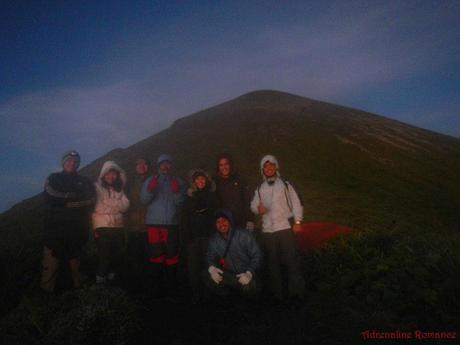
After securing our tents, making sure they won’t be blown away whenever a gust of wind blows, we started our trek up Mt. Kanlaon’s cone, its glorious crown. It takes around 30 to 45 minutes to climb the volcanic cone.
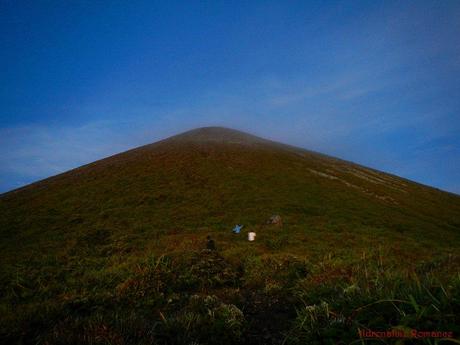
The first quarter of the climb involved trekking along shrubbery and grasses that were sometimes waist-high. Good-quality trekking pants and armguards are strongly recommended here because the plants are quite sharp and prickly. Contact to the skin can cause scratches and rashes.
Also, be careful and watch your step when climbing here. In some places, thick vegetation covers the trail. You won’t know that you’re stepping on a deep trough since the thick vegetation conceals it.
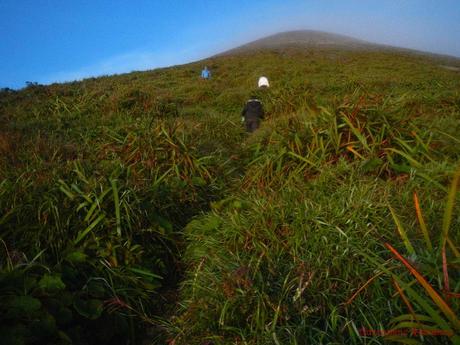
The terrain became more manageable once we got out of the shrubbery section and into the rocky slope. Still, it was important that we watch where we place our foot since we were walking on loose rock.
Every now and then rocks can be jarred loose and roll down below, endangering climbers directly below you. It is advisable that your team members spread out to lessen the danger of being hit by loose rocks.
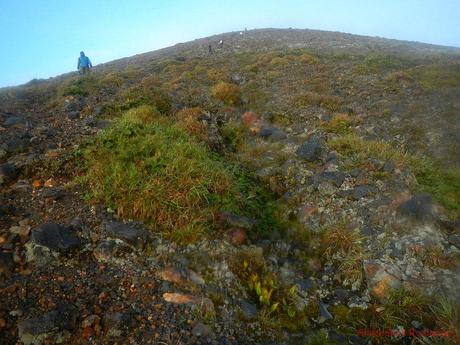
A brand-new, hope-filled day dawned upon Mt. Kanlaon and Canlaon City. As we climbed higher up the cone, we saw layers upon layers of stratus clouds forming far away, forming a serene sea of clouds.
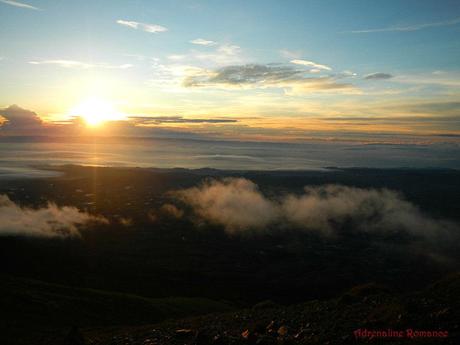
Fingers of low-lying clouds poured over the Eastern Saddle and into the bowl of the Margaha Valley. It was indeed a beautiful, ethereal view; but we were concerned that the clouds would also cover the cone. That would leave us unable to view the heart of Mt. Kanlaon—its crater. Fortunately, the wispy clouds stayed down.
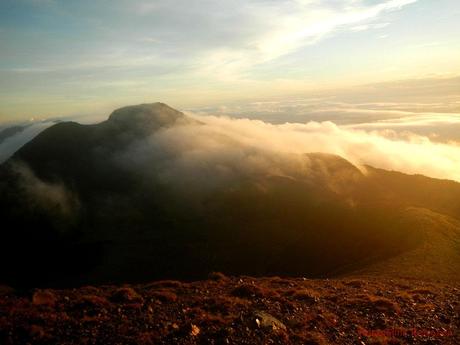
Half an hour later, we saw a cairn (man-made pile of rocks), a line of rocks, and a massive horn in the distance. Finally, we arrived at the summit!
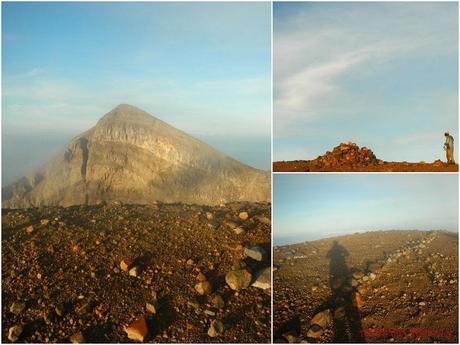
Mt. Kanlaon’s crater consists of an enormous cone of massive, sheer vertical stone cliffs that plunge hundreds of meters towards the heart of the mountain. Anyone who falls here is as good as dead due to the immense height. Even though if the person somehow survives the fall, there’s practically no way of retrieving him out of the crater short of having a daredevil pilot/rescuer fly a helicopter into the crater.
The true peak of Mt. Kanlaon is the “horn” in the photo below. Sir Tbong told me a few people attempted to traverse a knife-edge portion that forms the perimeter of the crater to get to the peak. The way is so scary and dangerous that they had to turn back to the staging point halfway.

To have a glimpse into the crater, one has to crawl prone at the very lip of it. Standing at the very edge is a no-no because a strong wind can blow you over the lip. One false, careless move here and you’ll fall to your death. Yes, we’re deadly serious.
Gazing down at the mouth of a volcano is an exhilarating, overwhelming experience that left us with a profound sense of humility and awe. Here, any perception of being extraordinary, special creatures of this earth is erased. We are a very small part of this world, and nature can easily consume us. The spirit of Mother Nature is so immense and encompassing that there is no way we can comprehend her powers at play.
The spectacular grandeur that is displayed in front of us utterly revived our respect for the earth.
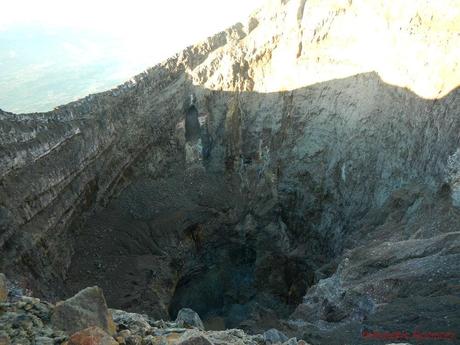
Let’s check out some of the interesting things inside the crater. A huge prominent cavern bores at one side of the crater wall. This could be the entrance of a large lava tube.
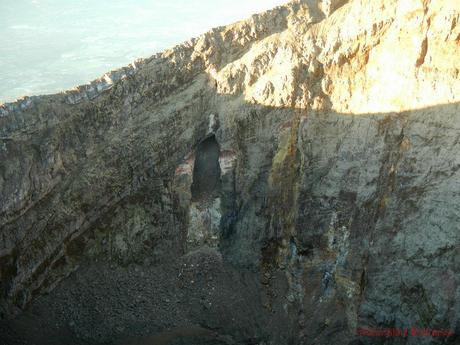
At another side of the crater is this old landslide, which occurred in an earlier eruption.
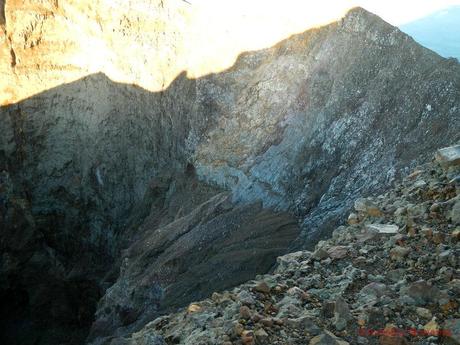
This is a doorway to the Earth’s mantle, the heart of Mt. Kanlaon. This is the true crater of Mt. Kanlaon, which lies hundreds of meters deep into the mountain. As of now, the volcano is sleeping. But since Mt. Kanlaon is one of the most active volcanoes in the country, the god can wake up anytime soon. When he does, everything feels his wrath.
The god actually awakened in 1996 without warning. According to the guides, several mountain climbers “teased” the god by dropping large stones into the crater. The volcano suddenly exploded, hurling enormous boulders, thick ash, and hot gasses. Sadly, the god’s wrath took the lives of three mountaineers and injured 17 others.
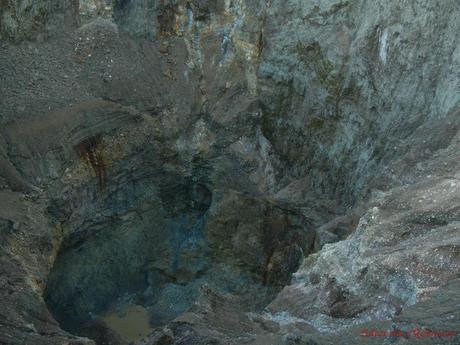
Selfie time! Sweetie and I sat just a foot away from the edge of the crater.
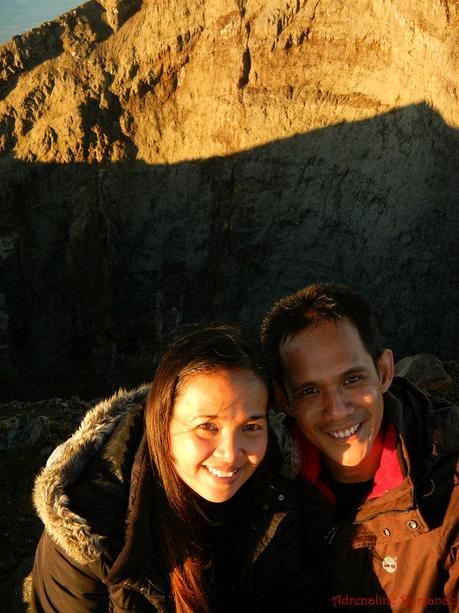
The summit area is rocky and almost devoid of plants. That’s why the tip of Mt. Kanlaon looks bare when viewed from a distance. Soil quality is so poor and the altitude is so high that most vegetation can’t survive here.
Also, check out that line of rocks that occupy a quadrant of the photo below. In the aftermath of the 2012 Visayas earthquake, Mt. Kanlaon guides discovered a long crack that appeared at one edge of the crater’s lip. As a precaution, they lined up rocks along the crack to indicate that stepping on the area within that fence of rock is prohibited.
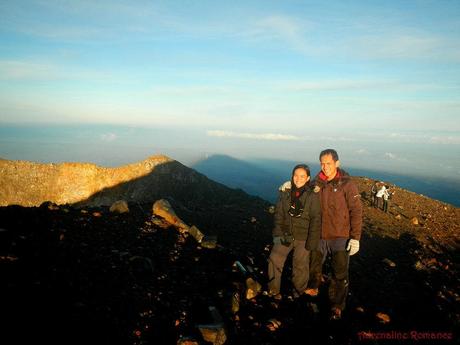
Of course, there is always that set of mandatory poses for Facebook. Hehehe! Hey, why not? After all, it’s not every day that we can step on its sacred slopes, right?
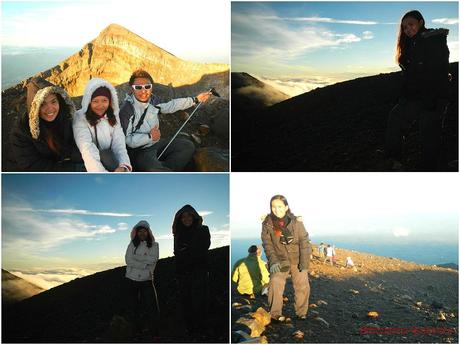
The summit straddles both Negros Occidental and Negros Oriental. Here, we were able to view the lowlands and cities of Negros Oriental such as La Carlota, Murcia, and Bago.
That cloud covered slope contains the Wasay trail, an extremely long mountain trail that takes 2 days to complete. However, undertaking the trail is worth it as the exit point is directly in front of the gate of Mambukal Mountain Resort in Murcia. And you do know how hot springs soothe all those sores and aches, don’t you?
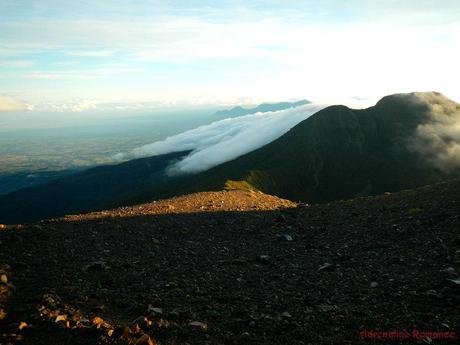
I did a time-honored mountaineering tradition in Mt. Kanlaon. After reaching the summit, the climber is required to put a stone on top of that cairn. He or she then pauses for a moment of silence to honor the mountain spirit.
We did that and a little more: we paid respects to the people who successfully visited Mt. Kanlaon’s sacred peak and those who perished on its slopes.
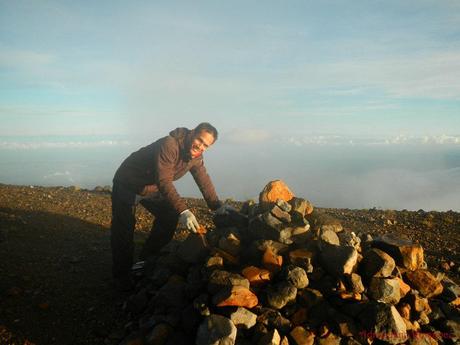
What an excellent team of fun-loving, positive, responsible, and determined climbers!
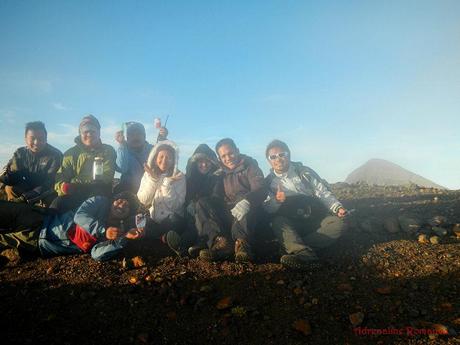
Acclaimed mountaineer and 2005 National Geographic Adventurer of the Year Ed Veisturs once said, “Getting to the summit is optional. Getting down is mandatory.” Yes, it was time to get down safely and prepare ourselves to exit the mountain.
Can you spot our campsite on the mountain’s shoulder?
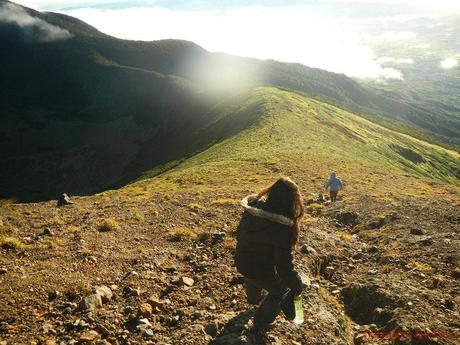
As the sun rose higher, the clouds that covered the Margaha Valley parted. See that secondary high peak in the photo below? That’s Makawiwili Peak where we took our lunch yesterday. You can also clearly see that treacherous ridge and lip from Makawiwili Peak to the Eastern Saddle.
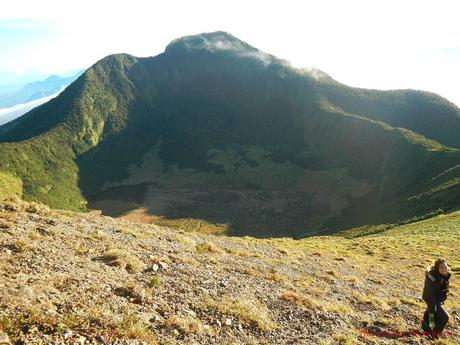
It would definitely be a wonderful blessing to see sights like these, with checkered fields and lush valleys far below you. Sweetie was ecstatic, knowing that she’s in the skies.
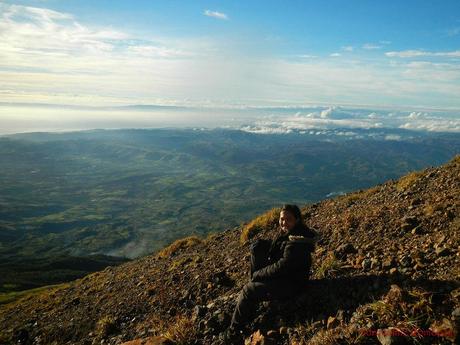
After carefully trekking down the rocky cone, we were finally back at our campsite, happy for having successfully reaching Mt. Kanlaon’s summit.
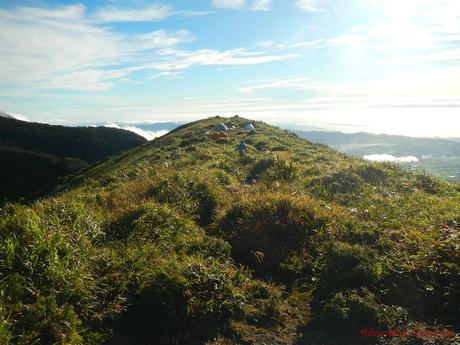
Sweetie prepared our favorite breakfast viands: fried rice, scrambled eggs, nido soup, and tocino.
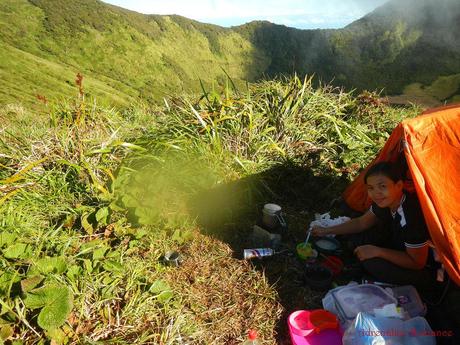
Just check out that awesome view of the volcanic cone from our tent!
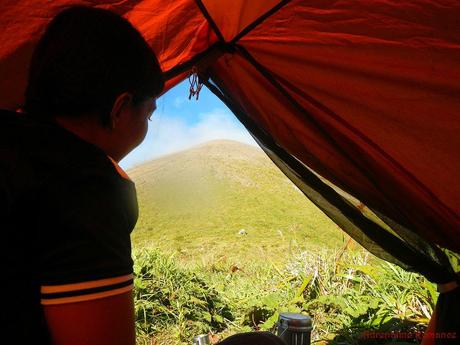
A yummy breakfast at more than 2,000 meters above the sea!
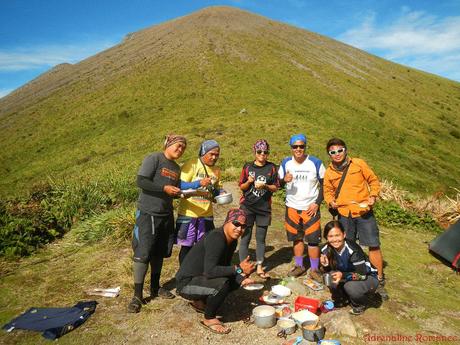
Oh, we did promise you some explanation about the gorgeous Margaha Valley in the previous article right? Well, Margaha Valley is not technically a valley. It is an ancient caldera, which, after thousands of years, has been overgrown with forests. A caldera, which is generally shaped like a bowl or cauldron, is created when the land collapses after a violent volcanic eruption. The collapse of the land is usually catalyzed when the magma chamber under the volcano is emptied out during a large eruption. With most of the magma ejected, the chamber could not hold the weight of the ground above it, triggering the collapse and the formation of the caldera.
Considering the immense size of the caldera, the original Mt. Kanlaon must have been gigantic, perhaps dwarfing many other mountains in the Philippines.
Margaha Valley also features a crater lake, which fills up with rainwater. According to the guides, the water there is thigh-deep and quite cold. We would have wanted to go down and visit Margaha Valley, but that was not in our itinerary. We’ll be back for you, Margaha Valley.
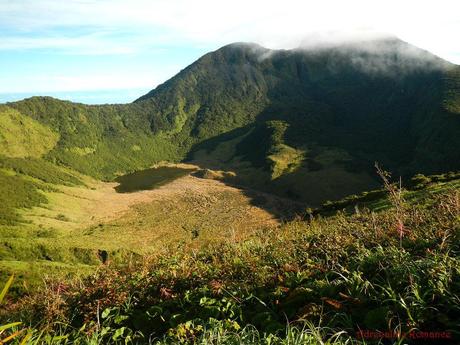
Here’s a closer look at the Makawiwili Peak from the Eastern Saddle. See how vertical that wall is? And check out the right side of the photo. Can you see that scar amidst the tree-covered cliff? That is a huge landslide triggered by rains during the wet season.
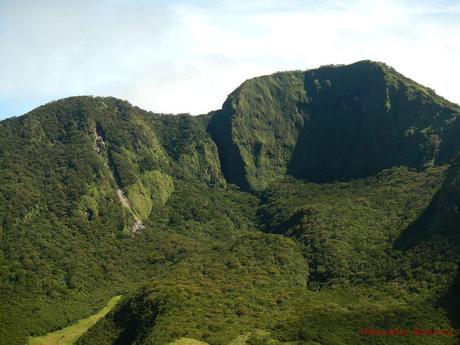
The cone of Mt. Kanlaon in full daylight and without cloud cover is simply spectacular.
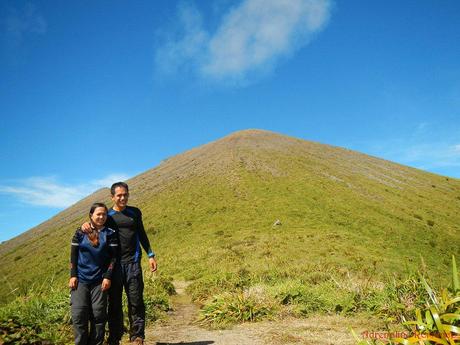
At the east side of the Eastern Saddle opposite of Margaha Valley, we were treated to a morning spectacle: a sea of clouds below us. From here, it looks like a strange, heavenly realm.
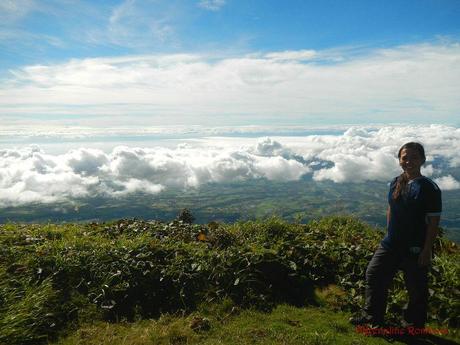
The photo below gives you idea of just how high we are. Check out the farms below; they look like chalkboards!
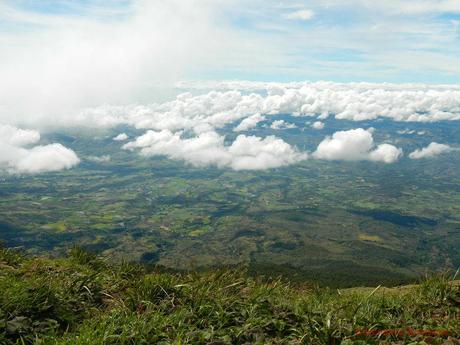
At around 9:30 AM, we bid goodbye to the mountain god, who gracefully let us sleep in his bosom and who showed us his power and wonder. As if on cue, wisps of clouds moved in to obscure the peak, once again hiding it from the view of mortal eyes.
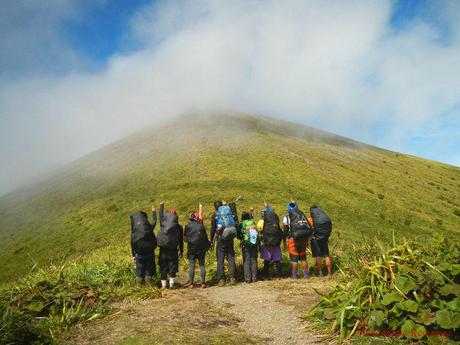
We descended using the Mananawin trail, a vegetation-covered trail that required several hours of knee-shattering, non-stop downhill trekking to complete.
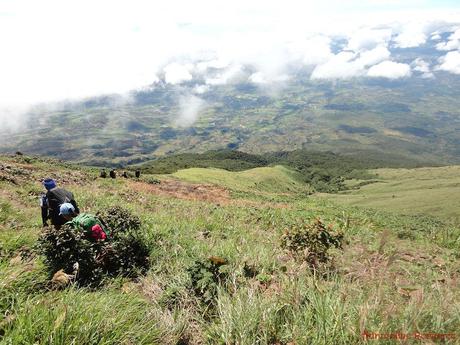
Almost forlornly, we had our last glimpses of the magnificent mountain god. It will probably be a year or two before we can visit Mt. Kanlaon again.

However, the punishing trail also offered offers majestic and rewarding views of the mountain and its surroundings.
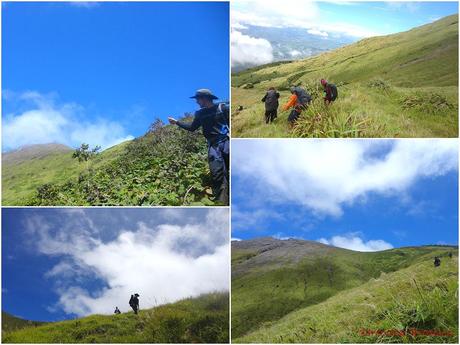
The Mananawin-Pula trail junction was where the team came into the mountain’s cloud level. Awesome!
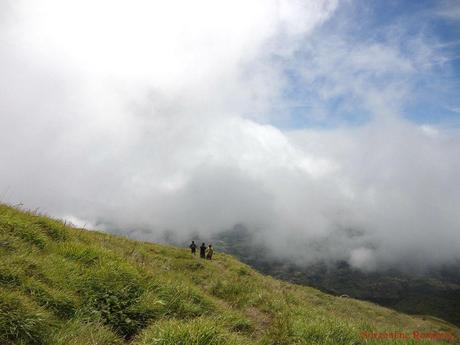
Beautiful wild flowers along the trail were aplenty.
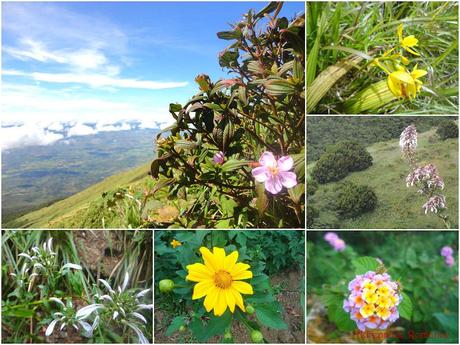
After several hours of walking in the open grasslands, we sighed in relief as we entered the forest area of the trail.
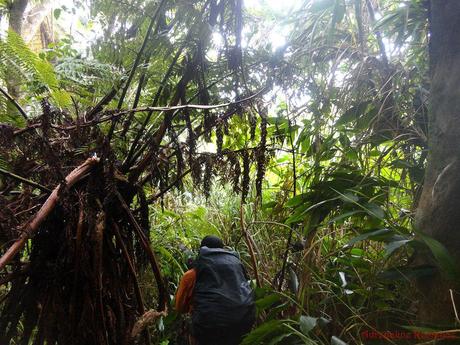
Here are some of the few interesting things we saw while inside the forest: a little bird’s newly made nest, juicy wild berries (they taste sour in the mouth but bitter in the throat), and small flowers that look like…well…you know. Princess Anina’s ehem, perhaps?
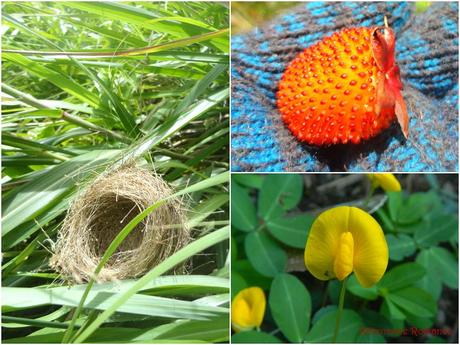
Parts of the forest trail are tricky to navigate. We had to crawl under tunnels of vegetation, step on slippery and muddy trails, hold on to roots and branches for balance, and even use ancient trees to brace ourselves.
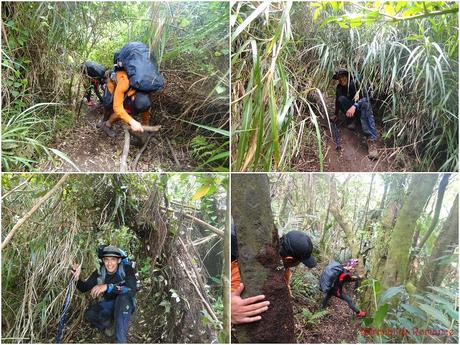
At noontime, we reached Patay na Sapa (literally, Dead River) where no water flows anymore. However, Mother Nature is anything but predictable, and what is normally a rock-strewn riverbed may become a raging highway of water during rainy season. Guides said that several people have already perished here after being washed away in unexpected flash floods.

Sentinel Rock is the main feature in Patay na Sapa. The moss-covered rock has features that make it appear like a human face, watching over the river.
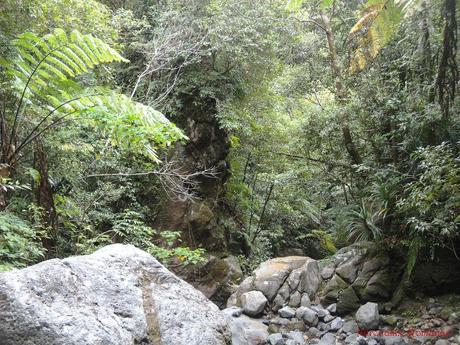
After a quick rest at the other side of Patay na Sapa (and to escape the annoying, buzzing bugs around), we continued on to the exit. The uphill climb was a welcome respite against the knee-shattering downhill trek.
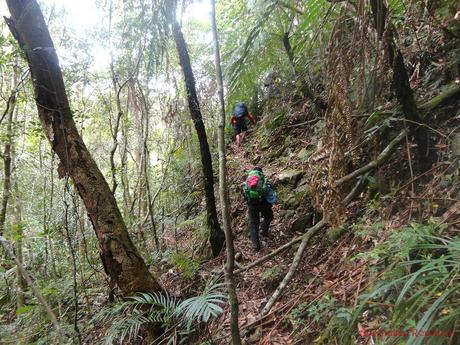
We then entered a large section of light woods, which means that we were now at the edge of the forest. Signs of civilization such as faint drones of motorcycles, water pipes, and small amounts of trash gave us determination to push our tired bodies forward. The agony was almost over.
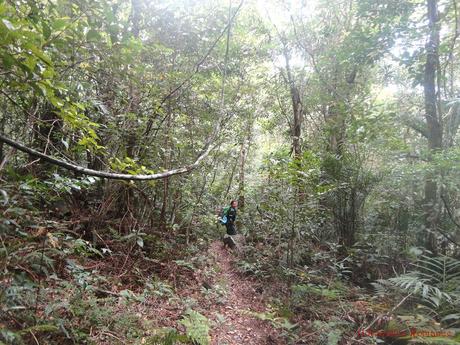
A small clearing immediately after the forest line served as a nice place to take a quick lunch on the trail. A nearby hose pumping potable water from a mountain spring served as our water source.
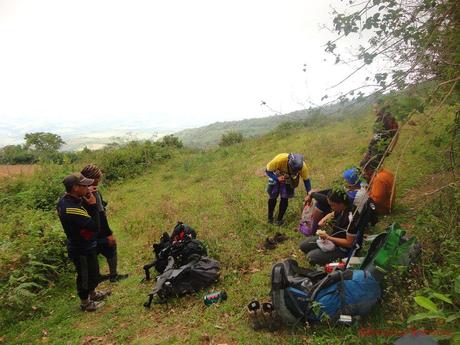
After lunch, we left the clearing. In just a few minutes, and like a welcome balm, the scenery opened to vast rice terraces and farms. Finally, we were back in civilization.
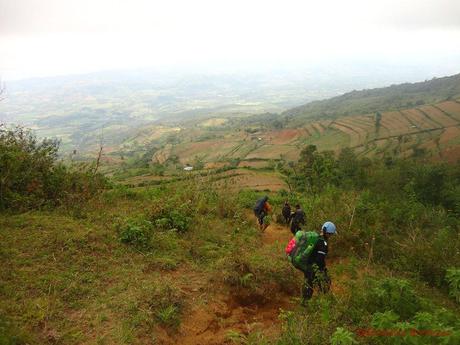
We were treated to snippets of simple rural life while we went down the mountain to our exit point. For us, city people, it is quite difficult to comprehend how these hardworking people can be happier, healthier, more relaxed, and more satisfied than us even though they have less money or material possessions than us. Salute to them!
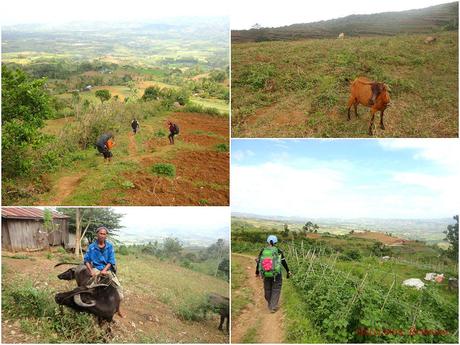
We arrived at the exit point with sore legs and tired feet. Thankfully, the Bolivar brothers were waiting there to immediately drive us to their humble but beautiful Bolivar’s Nature Resort. When we saw the swimming pool, we knew right away that we were in for a well-deserved reward.
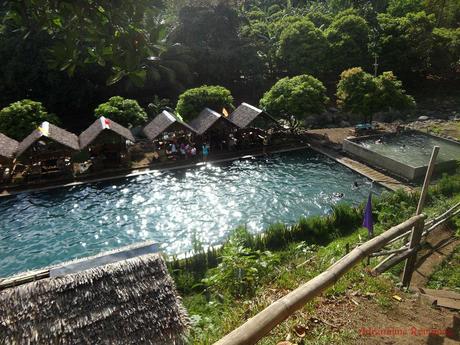
Ah, this is the life! Nothing can be more rewarding and relaxing having a refreshing swim in a spring-fed swimming pool; eating a dinner of mongo soup, tocino, and bulinao (fried and salted anchovies); chatting about the adventure with fantastic team-mates; sharing stories with our wonderful guides and the owners of the resort; a cool freshwater shower (finally!); and, best of all, a good night sleep in the open.

We woke up and stretched to a beautiful day and had a nice shower and a filling breakfast. Check out Mt. Kanlaon in the background.
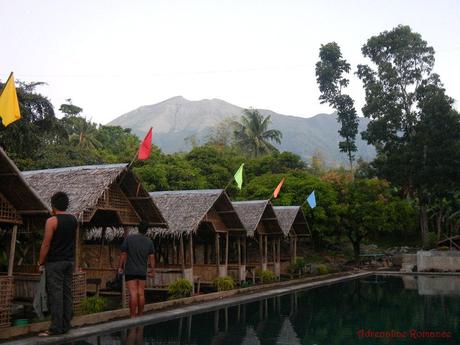
After packing up, it was time to say goodbye. Farewell, Mt. Kanlaon. Thank you for letting us safely climb your slopes. Thank you for showing us your indescribable wonders. Thank you for teaching us valuable lessons in life. Thank you for putting us back in place within Mother Nature. We will visit you again.
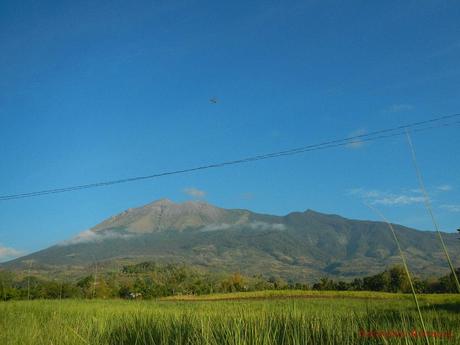
This climb wouldn’t have happened without the help of some very special people, and we would like to dedicate this little section to them. Thank you!
- Sir Joel Olivares for proposing the climb and taking care of our climbing permits.
- Sir Jigz Santiago and Sir Laddie Lamis for arranging everything and coordinating the elements of our climb.
- Sir Eduardo Alipar, Sir Arly Avila, and Sir King Besario for being excellent guides and for the superb guiding service
- Sir Steve Bolivar and bro for the rides and the accommodation at their humble but excellent resort Bolivar’s Spring Resort
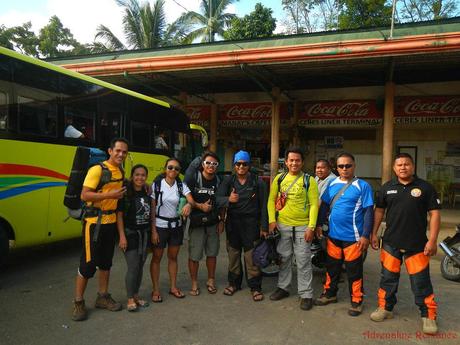
Tips to follow







